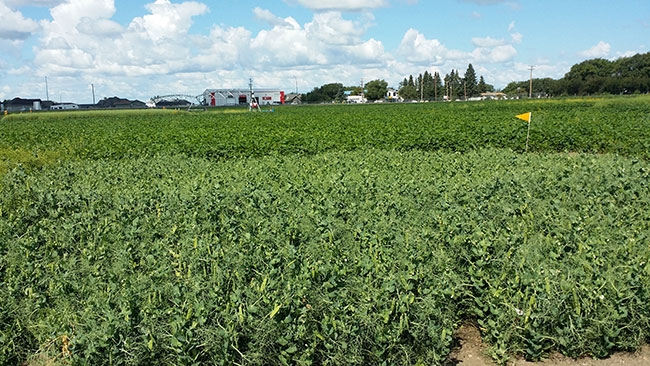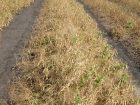
Features
Agronomy
Pulses
Marrowfat pea could get premium pricing, but challenges exist
Marrowfat pea is a very large-seeded, green-coloured pea with a blocky shape and a unique taste that makes it the pea of choice for certain specialty markets. Depending on the marketplace, this pea can command a premium price, but it has some challenges.
March 1, 2018 By Carolyn King
 Kruger is assessing whether mustard intercropped with marrowfat pea can help to hold the pea plants upright and improve standability. Marrowfat pea is a very large-seeded
Kruger is assessing whether mustard intercropped with marrowfat pea can help to hold the pea plants upright and improve standability. Marrowfat pea is a very large-seeded“In Britain, marrowfat peas are really popular as a side dish called mushy peas, and in North America they are favoured as a snack food. That’s because they have slightly higher fat and sugar contents than other types of dry peas, so they are a pleasant tasting pea,” says Gary Kruger, an irrigation agrologist with Saskatchewan Agriculture. Marrowfat peas are also used for other products like snack foods in Asian markets and as ingredients in soups and other foods.
Joerg Klempnauer, who owns Alberta-based Columbia Seed Co. Ltd. (CSL) with his wife Petra, is very familiar with the marrowfat pea market. CSL, a contractor, processor and marketer of specialty seed products, has been handling marrowfat pea for over 40 years. “We are still supplying the customers in Asia that we have from those days and more, expanding our market every year,” he says.
Klempnauer explains that the global marrowfat pea market is quite small. “We estimate a total world trade of maybe 30,000 tonnes. There are no true numbers available, but that is what we have gathered over the years from other exporting companies and processors.” It doesn’t take much extra production to oversupply such a small market and cause prices to drop.
“We are paying our farmers about $13 or $14 a bushel for marrowfat peas at present – we were up to $15 and $16 about five years ago, but the market has come back down; competition is stronger and we have to sharpen our pencils more. However, if you look at that price against a normal green pea price of maybe $8 or $9, it is enticing to grow marrowfat peas. But they are only worth that money if you have someone who can market them,” Klempnauer says. If growers can’t sell their marrowfat peas into the high-value food market, then the only option is the feed market.
“So, my suggestion is that growers look for a reliable, serious marketer and processor. If you don’t have a contract in hand that specifies what happens with the product if it doesn’t meet certain criteria I would not sign the contract and I would not produce marrowfat peas. I definitely don’t encourage anybody to produce marrowfat peas on spec; they are bound to go to the feed mill!” He adds, “All you need is around 2,000, 3,000, or 4,000 tonnes of product not contracted with a purpose to undermine the whole thing.”
Kruger notes that production contracts also help ensure the product will meet the customers’ specific requirements. “The visual assessment of marrowfat peas is quite important. The peas need to be large, and they need to be green; a premium product doesn’t have bleaching,” he says. “Also, some of the markets don’t like to have a desiccant applied; they want the peas to be swathed. That helps with the green colour and it also helps with preventing residue that might be a problem for certain specific food markets.”
Marrowfat pea production is similar to production of other dry peas. “Although breeders have improved yields, marrowfat peas still tend to yield a little less than regular peas,” Kruger notes. “That has become more of an issue recently because of the problem we’re having with root rots in pulse production, especially in peas. Aphanomyces root rot is rearing its ugly head and it is pretty widely distributed. A lot of that has to do with crop rotation issues and heavy rainfall. Field peas just don’t handle heavy rainfall really well; they can’t tolerate wet feet.” Aphanomyces root rot thrives in soggy conditions, and peas are one of the pathogen’s favourite hosts.
Kruger offers a few tips for fertility management of marrowfat pea and other dry peas. “Potassium isn’t something that shows up in research trials as being responsive, but in my opinion, it’s important from a general plant health viewpoint. As for micronutrients, I don’t think peas are very responsive to them. Peas are strongly mycorrhizal [forming a strong partnership with soilborne mycorrhizal fungi that help improve plant nutrient uptake], so for the most part peas will find the nutrients they need.”
He recommends applying some phosphorus during the pea year of a rotation. “You can get by without applying phosphate; it won’t affect your pea yield. But peas are kind of a scavenger crop, so your soil will be depleted in phosphorus after peas, and you’ll have to make up for it the next year. My personal opinion is you are better able to meet the needs of each crop in your rotation if you have more uniform phosphorus application rates from year to year.”
He adds, “There is some concern that phosphorus hurts the mycorrhizal nature of peas and that peas, being a fairly large-seeded crop, are maybe a little more sensitive to fertilizer injury when you put it with the seed. So I suggest applying no more than about 15 pounds of phosphate [per acre] with the seed. Another alternative would be side banding or mid row placement which would also allow a higher rate on par with crop removal.”
One of the issues with marrowfat pea varieties is that they tend to have poor standability. So Kruger is conducting field trials to see whether intercropping with mustard might help. He explains, “The goal of the mustard is to hold the marrowfat pea upright so it does not prematurely lodge but is able to reach its yield potential.” The mustard seeding rate he tried in 2017 was too high, so he plans to experiment with some lower rates in 2018.
Marrowfat pea usually performs well as an irrigated crop. However, for Saskatchewan growers, Kruger advises, “Because of the risks associated with Aphanomyces root rot and how widespread this disease is, I think irrigation of field pea is fairly risky at the current time. If we return to a drier weather pattern, its potential under irrigation will be greater.”
All of CSL’s marrowfat growers use irrigation to ensure the peas have the large size that the markets want.
Klempnauer’s other marrowfat production tip, “Make sure to harvest them early, and hopefully with higher than 16 per cent moisture [to reduce the risk of seed damage], and dry them in the bin to retain a good colour.”
Breeding better marrowfat pea
One of the Prairie pulse breeders working to improve marrowfat pea varieties is Deng-Jin Bing with Agriculture and Agri-Food Canada (AAFC) in Lacombe, Alta. Along with marrowfat pea, his breeding work includes yellow pea, green pea and maple pea, and he has also worked on various other pulses even some unusual ones like mung bean and lupin.
“Canadian marrowfat pea is primarily grown under contract production for export markets. There are specific demands for seed size and seed colour. Thus, improvement in seed yield, disease resistance, standability, large seed size and green seed colour are the priorities in AAFC’s marrowfat pea breeding,” Bing explains.
He has been breeding for improved marrowfat pea varieties for over 10 years. Initially, the main focus was to improve disease resistance, especially resistance to powdery mildew, and improve standability, because there were no marrowfat varieties with powdery mildew resistance and no varieties with good standability available on the Canadian market. “The combination of these two weaknesses had negative impacts on marrowfat pea production, including the increased susceptibility to other diseases, lower yield, reduced seed quality, difficulties in harvest and increased cost of production,” he says.
Through his breeding program, Bing and his team have been able to develop marrowfat lines that not only have the large seed size and green seed colour required by the markets but also higher yields, good standability and powdery mildew resistance.
Bing expects one or more of his program’s marrowfat pea varieties could be ready for release in early 2018, depending on the results of the 2017 field trials. He adds, “More varieties will be available in the future if the breeding program can get support for the coming years.”
“Continuous improvements in marrowfat pea characteristics are challenging since the marrowfat germplasm pool is much smaller than that of other field pea market types, and requirements for marrowfat pea are more stringent,” Bing notes. “Similar to other market classes of field peas, marrowfat pea also faces threats from root rot and Ascochyta diseases. Improvements in these areas are needed, but are very challenging. Pea weevil may also be a problem. Teamwork of the plant breeder, plant pathologist, molecular geneticist, entomologist and agronomist are required to solve or mitigate these problems.”
Weighing the challenges and opportunities with marrowfat pea, Kruger thinks pulse growers should keep it in mind as a possible crop. He says, “Given the desirability for some of the specialty food products made with marrowfat pea, I think it has potential – but that has to work in concert with the marketplace.”

